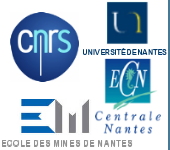Reconstruction of 3-D Microwave Images based on a Block-BiCGStab Algorithm
Résumé
In 3-D microwave imaging, gradient-based optimization algorithms usually make use of the so-called stabilized version of the biconjugate gradient iterative method (BiCGStab) in order to solve multiple linear systems. We propose to use a block version of BiCGStab to jointly solve the mutiple right-hand side linear systems. Illuminations are partitioned in subgroups, which makes the method more efficient. The reconstruction process is studied on realistic simulated data and illustrates the efficiency of the method compared to BiCGStab. 1. Introduction The development of microwave imaging algorithms has received a lot of interest in the last few years with applications such as biomedical imaging and geoscience [1, 2]. Solving the inverse scattering problem under realistic condtions presents several difficulties, a critical one being the reduction of the computational cost associated with three-dimensional problems. Nonlinear inversion methods usually rely on iterative algorithms to reconstruct the dielectric properties of the unknown object. A regularized data misfit cost function is minimized using a gradient-based optimization procedure, such as the Distorted Born iterative method (DBIM) [3] or the Gauss-Newton method [2, 4]. At each iteration, the computation of a descent direction and of a step size requires the evaluation of the objective function and of its gradient. Such computations rely on the resolution of linear systems equal to the number of illuminations. In practice, exact inversion of such systems becomes computationally prohibitive for large 3-D problems and approximate solutions are obtained with iterative methods, such as the conjugate gradient method [5], the quasi minimal residual (QMR) method [6] or the stabilized version of the biconjugate gradient stabilized (BiCGStab) method [1, 7]. Different methods have been proposed to solve efficiently such multiple systems, such as the marching-on-anything technique [4] or a massive parallelization scheme [2]. Since the linear systems share the same system matrix, block versions of iterative algorithms are appropriate, which simultaneously solve linear systems with multiple right-hand sides. In [8], a block-QMR algorithm was proposed for microwave imaging. In [9], a block version of BiCGStab was developed for random system inversion, which was shown to outperform the Block-QMR algorithm. In [10], we proposed a Partial-Block BiCGStab procedure to solve multiple forward
| Origine | Fichiers éditeurs autorisés sur une archive ouverte |
|---|
Loading...


